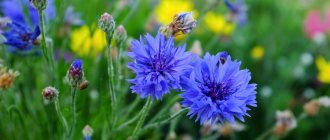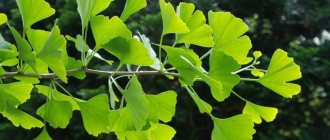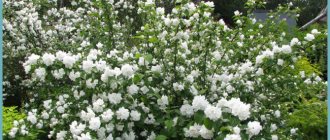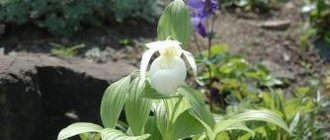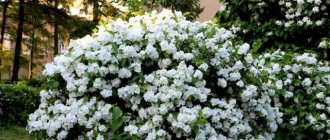Mock orange, which is often mistakenly called jasmine, is a picturesque spreading shrub that, in late spring, is covered with thick white flowers, the captivating scent of which will take your breath away. It has nothing in common with jasmine, an exotic shrub from the Olive family that grows in Asia and Africa. How to grow mock orange, planting and care in open ground, as well as interesting species and varieties are discussed in this article.
General description of terry mock orange
In fact, mock orange is not a jasmine, but people call it that because of the aroma of fragrant flowers, which is very similar to the fragrance of real jasmine flowers. However, these ornamental plants belong to different families, just as the zones and conditions for growing crops are different.
Garden jasmine or terry mock orange is a deciduous shrub with a height of 1.5 to 3 m, obtained by the French breeder Lemoine through experiments with common mock orange. The ornamental plant is distinguished by double flowers that resemble miniature roses in a half-bloomed state. There are double and semi-double varieties of garden jasmine with large-flowered forms and flowers with a small corolla, with a different number of petals, which affects the doubleness.
How terry mock orange blooms
The flowering of terry mock orange is unforgettably beautiful and long-lasting. Depending on the variety, the flowers, collected in inflorescences of several pieces, have varying degrees of terry. On average, garden jasmine blooms for 2-3 weeks, starting in mid-late June. It is worth saying here that double varieties of mock orange are not capable of emitting a strong aroma, unlike the inflorescences of ordinary mock orange. Their fragrance is subtle, barely perceptible, light. Mock orange pleases with lush, lush flowering only in sunny places and fertile soils.
Popular varieties of terry mock orange
The most popular and in demand varieties of terry garden jasmine among gardeners are:
- Virginal is the first variety of terry mock orange, obtained by Lemoine more than 100 years ago. A bush up to 3 m in height with large flowers blooms 2 times a year: in summer and autumn. Its aroma is sweet, quite strong, which is uncharacteristic for representatives of the double type of garden jasmine;
- Garden jasmine Minnesota snowflake. This terry mock orange shrub grows up to 2 m in height and is distinguished by dense double snow-white flowers, collected in inflorescences of several pieces;
- Pyramid. This is a tall, up to 3 m, late flowering shrub. Snow-white flowers abundantly cover the powerful bush, emitting a subtle, subtle scent;
- Schneeshturm. A bush of double mock orange up to 3 m in height, with drooping shoots that are abundantly decorated with luxurious double flowers that emit a refreshing, fruity aroma;
- Ermine mantle. A low, up to 1.8 m in height, variety with drooping branches, lushly decorated with creamy white flowers that exude a subtle strawberry aroma;
- Blizzard. This is a tall shrub, completely covered with snow-white inflorescences, which from a distance resemble large flakes of snow. Almost all the leaves of the terry mock orange are hidden under the luxurious “snow cover”;
- Moonlight. A variety with small pom-pom flowers that appear in huge numbers and exude a strawberry aroma and glow in the dark.
According to experienced gardeners, in the conditions of the domestic climate, varieties of terry jasmine of Russian selection take root and bloom best. These are Blizzard, Yunnat, Moth Ballet and others.
Where to plant mock orange
Mock orange loves open sunny spaces, but also feels very good in partial shade. Purely theoretically, you can plant it even in a dark corner of the garden, and the bush will not only not die, but will also delight you with its flowering. However, it will no longer be the shrub strewn with white flowers that you are used to seeing, but its pale copy. However, if you are not chasing lush flowering and a small number of flowers is enough for you, then mock orange can be an excellent option for landscaping a shaded area.
Mock orange is unpretentious to soils, but the most optimal for it will be fertile and well-drained soil of neutral acidity.
Main characteristics
The main advantage of the terry mock orange is its unpretentiousness - in order for the luxurious beauty of the snow-white flowering of the crop to be, according to the description above and in the photo, there is no need to perform complex agrotechnical techniques. Garden jasmine is a frost-resistant shrub that can withstand frosts up to 22 - 25 degrees, depending on the variety. This type of ornamental shrub has good immunity and is characterized by resistance to pests and diseases. However, it is important to carry out agricultural care techniques: remove fallen leaves in a timely manner, avoid waterlogging, provide the plant with the necessary amount of nutrients, which will ensure even greater plant resistance to infections.
Jasmine and mock orange - what's the difference?
Mock orange is a common shrub that is often called jasmine. These plants are completely different species, they not only have different appearance and needs, but also belong to completely different botanical families. Therefore, it is worth taking a closer look at them so as not to make mistakes.
Jasmine
Jasmine (Jasminum) is an evergreen plant from the Oleaceae family that we usually associate with white, fragrant spring bushes. It is a climbing or erect plant. All species except jasmine are not found in our country, because most jasmines are exotic plants. Jasmine (Jasminum nudiflorum Lindl.) is a shrub with long shoots and yellow flowers, similar to forsythia flowers, almost odorless. Flowers appear in early spring from February to April. These shrubs do not tolerate large temperature changes that occur in our climate, and therefore are not suitable for year-round cultivation.
Several types of jasmine can be grown in pots, and although they are not the easiest to care for, they can sometimes be grown in apartments for a long time, for example:
- jasmine multiflorum is a creeping shrub, green leaves and white, intensely fragrant flowers that appear on the plant in December-April,
- Indian (Arabic) jasmine or sambac is a climbing shrub with white, fragrant flowers collected in umbrellas, blooming in summer from June to September.
Jasmines are easily grown as ornamentals in many warmer regions of the world. Jasmine teas and aromatic oils are prepared from several types. The flowers of this plant are also used in cosmetics and perfumes. In our country, real jasmine can only be grown in pots at home, because the plant does not tolerate low temperatures.
Chubushnik
A completely different plant is mock orange (Philadelphus), which belongs to the Hydrangeaceae family. Its white, charming flowers are a delight every spring and summer and usually smell great, but some species and cultivars are almost completely odorless. In our country, two types are mainly grown:
- Downy mock orange (Philadelphus pubescens) – odorless;
- Crown mock orange (Philadelphus coronarius).
These are shrubs of varying heights (1-5 meters) and flowering periods, but all species grown in our country are characterized by sufficient resistance to low temperatures and low cultivation requirements. Therefore, mock orange can be successfully planted in sunny and shaded areas, as well as in good or weaker soils. The bushes will grow well in different conditions, they just don’t like drought.
Reproduction methods
You can propagate garden jasmine of double varieties in one of the following ways:
- seeds;
- layering;
- cuttings;
- dividing the bush.
Seed propagation is quite labor-intensive and requires a long waiting time. Only after 6 - 7 years will the plant be pleased with abundant, lush flowering. For layering, the strongest, strongest shoots are selected, which are fixed in a shallow trench around the bush at the base of the first bud. Shoots for rooting are sprinkled with peat and moistened. During the season they are hilled up twice and cared for in the standard way. With the arrival of autumn, young seedlings are separated from the mother bush and planted in separate beds for growing.
For cuttings in June, cut branches 10 cm long along an oblique line. Planting material is planted in a greenhouse, after keeping them in a root-stimulating solution. Seedling care is standard: moistening, airing and hardening after rooting. Strong, healthy seedlings are planted in a permanent place only the next year.
The most effective and less time-consuming method of propagation is dividing the bush. First, the terry mock orange bush is watered abundantly and carefully dug up. Divide the roots with a sharp knife or garden shears so that each division remains with basal shoots. Dividing the bush is carried out only for adult plants in the fall - from the end of September to the end of October.
small-leaved
Mock orange snowbel - description, planting and care
Mock orange is a small-leaved, low spreading bush. It can reach 1.5 m in diameter. It is very densely overgrown with small, green leaves. Blooms profusely in June-July. Long-flowering variety. Simple white buds cover the crown for about a month. It is more commonly called strawberry mock orange because of its wild strawberry or strawberry flavor.
Small-leaved mock orange
Important! The species requires regular, abundant watering.
Chubushnik - small-leaved varieties
Based on this species, hybrids were bred that retained their compactness and characteristic aroma.
The most popular of them:
- mock orange Mont Blanc;
- Snow avalanche;
- Caucasian;
- mock orange Yunnat;
- Ermine robe;
- Avalanche;
- mock orange Dame Blanche (blanche);
- Moonlight;
- Bouquet Blank.
Planting and caring for terry mock orange
In order to grow a decorative, abundantly flowering jasmine bush on your site, you need to choose a bright, sunny place, protected from cold winds and drafts. Mock orange can easily tolerate light shade, but the flowering of the crop even in partial shade will be scant, rare and short-lived. The soil must be fertile and loose. The ideal place is a small hill.
Important! Terry mock orange does not tolerate wetlands with high groundwater levels. Under such conditions, the root system of the plant begins to rot.
Recommended timing
Young terry mock orange seedlings are planted in spring or autumn. In early or mid-April, planting is carried out in regions with a temperate climate. In the southern regions, it is advisable to plant garden jasmine in mid-October: before winter it has time to get stronger and develop a good root system.
Site selection and soil preparation
The optimal place for terry mock orange will be a hill without standing water, protected on the northern and eastern sides. For example, near the southern wall of a house, building, fence. Since jasmine does not tolerate waterlogging, it is worth taking care of good drainage from broken bricks or gravel. The soil mixture should consist of leaf humus, compost and sand.
Landing algorithm
Sequencing:
- Dig planting holes measuring 60x60, maintaining a distance between them of 0.8 - 1.5 m. For low-growing varieties of terry mock orange, especially when creating hedges, maintain the minimum specified distance, for tall bushes when planting in groups - at least 1.5 m.
- A drainage layer of at least 20 cm is laid at the bottom of the pits.
- Pour some fertile soil and place the seedling vertically, making sure that the root collar does not go deeper than 2-3 cm below the soil level.
- The young mock orange is covered with fertile soil and the soil is compacted.
- Water generously and mulch with fallen leaves or humus.
Important! When planting garden jasmine in planting holes, add nitroammophoska (25 - 30g) along with the soil.
Application in the garden
Most often, mock orange is grown singly in gardens; with its flowering, the shrubs perfectly diversify the structure of flower beds and even the lawn. Ease of formation is a great advantage, which allows you to limit the bushes in height and width. The shrub is readily used to create hedges - formed and unformed, also in combination with other flowering shrubs.
Photo. Mock orange hedge
Mock orange should be planted in front of the house as an element that limits the view from the street, decorating the house, and also next to terraces and gazebos - as a source of shade and a wonderful aroma.
Cut branches can be used to make arrangements at home, which are not very durable, but create a very elegant decoration for the dining table.
You can also make a decoction of the leaves that effectively repels garden snails.
By the word “jasmine” most people mean mock orange. Although these plants do not have much in common, they both have a charming aroma. Therefore, it is worth adding a little natural aroma to your home or garden by planting this fragrant shrub. Mock oranges are easy to grow and make a strong statement in garden design.
Growing rules
Terry jasmine does not require special care. However, under no circumstances should the soil be allowed to become waterlogged or stagnate. Otherwise, the root system will begin to rot. But it is not recommended to allow the soil to dry out, since mock orange is still a moisture-loving plant. For rapid growth, active development and flowering, as well as successful overwintering, the shrub must be regularly fed with mineral and organic fertilizers. A mandatory method of agricultural technology is pruning mock orange - sanitary and formative.
Watering schedule
Watering terry jasmine is carried out with heated, settled water no more than 2 times a week. In rainy summers, watering is reduced to once a week, making sure that the soil in the tree trunk circle is not too waterlogged. For a single watering of an adult bush, 20 - 30 liters of water are required.
Important! Watering with cold water can lead to the development of infectious diseases.
Weeding, loosening, mulching
Weeding of the terry mock orange tree trunk circle from weeds is carried out as needed. Loosening is carried out 3-4 times per season, followed by mulching with fallen leaves or humus. This measure helps protect the soil from drying out and supplies the soil with nutrients. Mulching the mock orange must be done in preparation for the winter period: this gives the roots additional heating, as well as after spring pruning.
Feeding schedule
Fertilizing terry jasmine with mineral and organic compounds is carried out only in the 2nd year after planting. The feeding schedule looks like this:
- Annual watering in early spring - slurry diluted with water in a ratio of 10:1.
- Before flowering, mineral fertilizing with 30 g of superphosphate, 15 g of potassium sulfate and urea diluted in 10 liters of water will ensure lush flowering of jasmine. This amount of fertilizer is enough for 2 adult bushes.
- After flowering, mock orange needs mineral fertilizers, which are applied directly to the soil: 20 g of superphosphate and 15 g of potassium sulfate.
Trimming
Terry mock orange, especially the coronal one, needs crown formation. To give it a well-groomed, symmetrical appearance, long branches on the bush are cut off in early spring, and weak ones are shortened to the middle. After young shoots sprout through the awakened buds, they are removed without regret. On each stem, 2 - 3 strong, developed shoots are left. In the 3rd year, the mock orange bush takes on a beautiful shape and pleases with abundant, luxurious flowering. Every year, in early spring, it is mandatory to carry out sanitary pruning, removing old, dry, weak branches and all wilted flowers. Once every 5-6 years, rejuvenating pruning of the bush is carried out, cutting out almost all the branches. Only the main trunks, 4–5 cm long, are left, the rest are cut off near the base.
Important! After pruning the mock orange, all fresh cuts are treated with garden varnish, which will prevent the introduction of infection, the development of diseases and pests.
Preparing for winter
In central regions with a temperate climate, terry mock orange does not require shelter for the winter. If the tops of the shoots are damaged by frost, they are removed during sanitary pruning: the plant quickly recovers. Young seedlings that are less than a year old need shelter. It is organized using light-colored fabric - a special material, burlap - and tied with ropes.
Before the first frost, the soil around the tree trunk is deeply loosened and mulched with garden compost, humus or manure. In winter, make sure that the mock orange bushes do not bend under the weight of snow, and if there is a lot of it, then shake off the excess.
Varieties of indoor plants
At home, as a rule, several of the most common species are grown. They may differ in size and growth rate, but all of them are characterized by the presence of a fragrant white flower.
Jasmine Arabian Knights
This jasmine bush differs from its relatives in the speed of shoot growth.
Double flowers grow up to 1.5-1.7 cm in diameter. The most optimal conditions for growth are lightly shaded areas.
Arabian jasmine begins to bloom in March and ends in autumn.
Grand Duke of Tuscany
This variety is native to the Middle East. Although jasmine cannot boast of a growth rate, it does have fairly large flowers - 4-5 cm in diameter.
The Duke blooms only a few days a year, after which the double buds dry out. You can place a pot with a bush on the sunny side of the house, but it prefers shaded places.
Grand Duke of Tuscany
It tolerates dry soil quite easily, but it is better to water it on time. If the room is very hot, the flower should be sprayed and moistened more often.
Jasmine Maid of Orleans
The fast-growing and unpretentious variety is the most popular variety of indoor jasmine.
On a note! The Maid of Orleans blooms all year round, but the plant is most active in spring and autumn.
Small flowers, having blossomed, live only for a day, and they are replaced by the next. The plant can feel comfortable even at a temperature of +10°C.
Maid of Orleans
Jasmine Belle of India
The domestic variety has an average growth rate. Flowering occurs all year round, the buds grow up to 30 mm in diameter.
Indian jasmine looks brightest in spring and summer. For more luxuriant flowering, it needs to be provided with sufficient lighting and watering rates.
Belle of India
Pests and diseases
Terry varieties of mock orange are a plant that is resistant to diseases and pests and has unbreakable health. Among the pests, aphids, weevils, and spider mites pose a great danger to jasmine. They are combated with the help of insecticides. For preventive maintenance during spring treatment of shrubs, experienced gardeners advise using a solution of laundry soap. In this case, a piece of grated laundry soap will require 10 liters of warm water. A simple and affordable remedy will eliminate the risk of pests and infectious diseases.
Preparing for winter
Mock orange, especially varieties bred in our latitudes, are frost-resistant plants. There is no need to worry about mature bushes. They overwinter well, and in case of slight frostbite on the upper shoots, pruning is carried out in the spring and the mock orange quickly recovers.
Young seedlings planted this season need to be prepared for the cold. First of all, you need to insulate the root layer of the earth using peat, compost and soil; it is recommended to tie up the bush itself and cover it with burlap or agrofibre.


